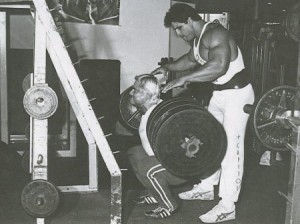What is the best rep range?
Are different ranges recommended for fast loss vs gaining muscle? I’ll give you the best answer I can based on the research and the people I respect the most in the fitness industry.
Rep Range for beginners:
Most beginners want to come to the gym to burn fat and gain muscle. It seems somewhere in the 5-8 rep range is ideal for both.
Beginners and Fat Loss:
Let’s first talk about fat loss. Some people assume using light weights for higher reps is the best way to lose fat (women in particular are often afraid lower reps will make them big and bulky). But lower rep ranges seem superior for fat loss. One study, for example, compared the metabolic effect of training with 8 reps vs training with 15 reps on female trainees:
PURPOSE: To compare the effect of low- and high-intensity resistance exercise of equal work output, on exercise and excess postexercise oxygen consumption (EPOC).
METHODS: Fourteen female subjects performed a no-exercise baseline control (CN), and nine exercises for two sets of 15 repetitions at 45% of their 8-RM during one session (LO) and two sets of 8 repetitions at 85% of their 8-RM during another session (HI). Measures for all three sessions included: heart rate (HR) and blood lactate (La) preexercise, immediately postexercise and 20 min, 60 min, and 120 min postexercise; and ventilation volume (VE), oxygen consumption (VO(2)), and respiratory exchange ratio (RER) during exercise and at intervals 0-20 min, 45-60 min, and 105-120 min postexercise.
RESULTS: Exercise .VO(2) was not significantly different between HI and LO, but VE, [La], and HR were significantly greater for HI compared with LO. Exercise RER for HI (1.07 +/- 0.03 and LO (1.05 +/- 0.02) were significantly higher than CN (0.86 +/- 0.02), but there were no differences among conditions postexercise. EPOC was greater for HI compared with low at 0-20 min (HI,1.72 +/- 0.70 LO(2); LO, 0.9 +/- 0.65, LO(2)), 45-60 min (HI, 0.35 +/- 0.25 LO(2); LO, 0.14 +/- 0.19 LO2), and 105-120 min (HI, 0.22 +/- 0.22 LO(2); LO, 0.05 +/- 0.11, LO(2)).
CONCLUSION: These data indicate that for resistance exercise bouts with an equated work volume, high-intensity exercise (85% 8-RM) will produce similar exercise oxygen consumption, with a greater EPOC magnitude and volume than low-intensity exercise (45% 8-RM).1
Those who trained using eight reps experienced a greater metabolic effect than those who did higher rep training. Craig Ballantyne used studies like this to develop Turbulence Training. (women who are interested in body transformation should check out Bikini Body Workouts).
Beginners and Gaining Muscle:
What if gaining muscle mass is your primary goal? We’ll start by looking at the American College of Sport Medicine’s position on this:
For novice (untrained individuals with no RT experience or who have not trained for several years) training, it is recommended that loads correspond to a repetition range of an 8-12 repetition maximum (RM).2
Many of the guys I follow have come to very similar conclusions. Jason Ferruggia recommends the 5-8 rep range for beginners–this is what he uses in the Muscle Gaining Secrets program. Beginners, he argues, risk injury if they try to use higher reps because their stabilizer muscles are still relatively weak (the risk of injury on exercises like squats and deadlifts is of particular concern).
It seems 5-8 range is an ideal combination of intensity and volume. This yields the best gains in size and strength. Generally speaking, these two go together—the stronger you get, the bigger you’ll get.
Intermediate/Advanced: Size and/or Strength
Let’s go back to the previous study. Here’s the position statement on more intermediate/advanced trainees:
For intermediate (individuals with approximately 6 months of consistent RT experience) to advanced (individuals with years of RT experience) training, it is recommended that individuals use a wider loading range from 1 to 12 RM in a periodized fashion with eventual emphasis on heavy loading (1-6 RM) using 3- to 5-min rest periods between sets performed at a moderate contraction velocity (1-2 s CON; 1-2 s ECC).3
The study mentions to things: 1) utilizing a wider load range, and 2) periodization.
Experimenting with different rep ranges can be especially helpful for building mass. The legs, for example, tend to have a wide range of muscle fiber types (fast twitch and slow twitch) and often respond to high rep training. One of the most famous old-school methods for building mass is the 20-rep squat routine (called “breathing squats,” because you’ll be gasping for breath between reps). Tom Platz, known for his remarkable leg development, often included high rep squats into his routine.

Periodization is great for increasing strength in more intermediate/advanced trainees. The idea is pretty simple: you start with lower weights and higher rep ranges. Over time (weeks) you lower the volume and increase the weight.
Conclusion:
Beginners looking to lose fat or gain muscle (or both) would most likely benefit from routines based on the 5-8 rep range.
Intermediate/Advanced trainees will probably continue to find some of their best results still come with 5-8 reps. But they can experiment with wider rep ranges (including high reps) and should consider periodization for developing greater strength.
I’ve tried to give a quick survey of what I’ve learned about this topic. Every responds differently to training, so don’t interpret this article as “set in stone” for every trainee. It is more of a guide for what will work the best for most people.
I’d highly recommend you check out my list of recommended programs if you need more guidance in how to set up your training.
References:
1. Effects of resistance exercise bouts of different intensities but equal work on EPOC.
3. Ibid